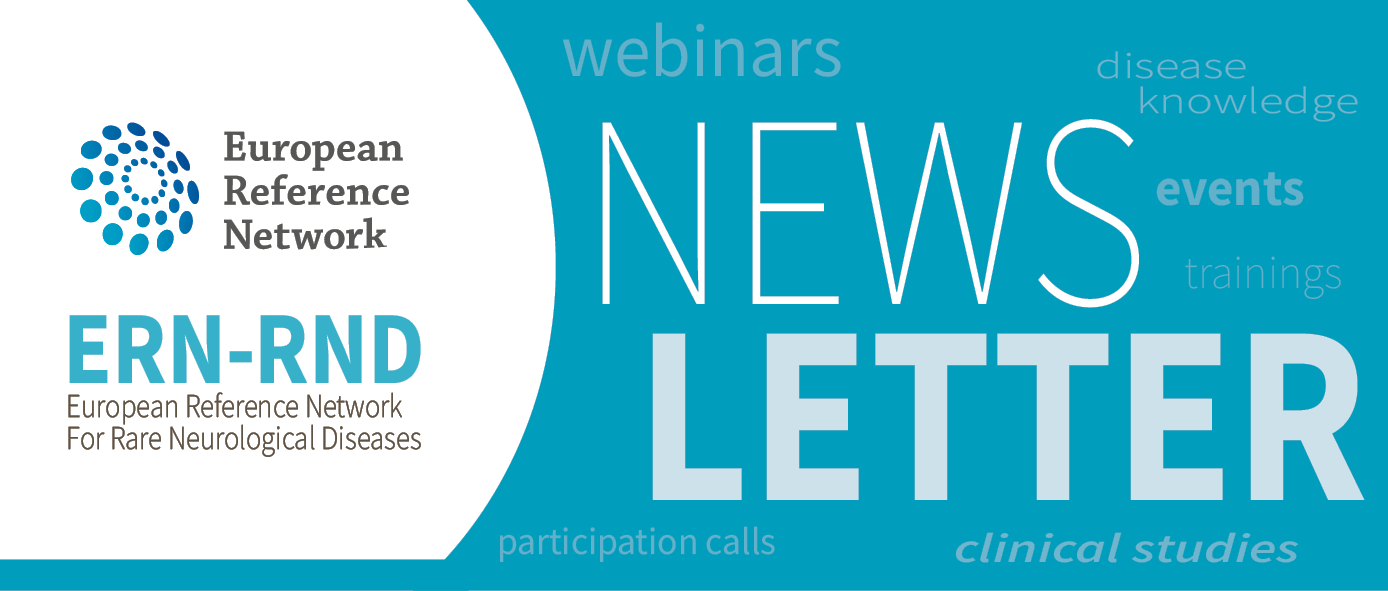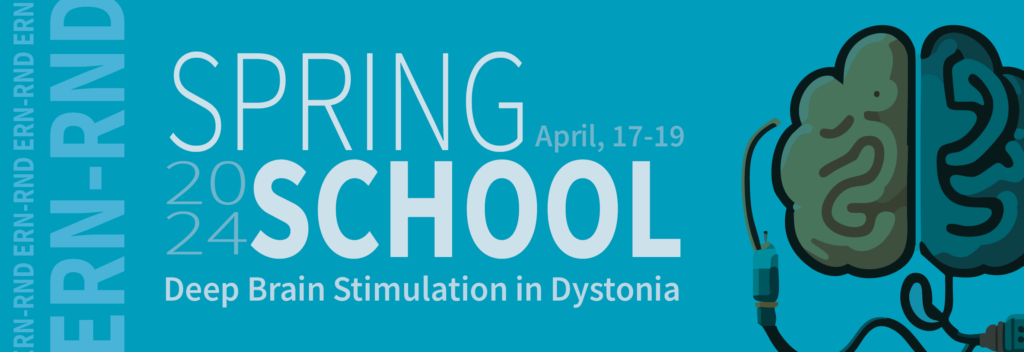
|
|
|
|
|
we are looking forward to meeting you at this year's EAN Congress: come and visit us at our booth N27 and don't miss our Scientific Theatre on Dystonia and Huntington's Disease on July 1st. Join also our (N)Euro-Café or take a picture at our photo booth "Shine Light on the Invisible" (N28) - our common activities with EFNA and the ERNs epiCARE and EURO-NMD.
|
Did you miss a session of our Spring School "DBS in Dystonia"? You can now watch the sessions here. And another deadline is coming up: The next national workshop organized by the EC will be held in Dublin on June 17, on-site and online - registration deadline is June 7.
|
What else awaits you in this issue? An interview of Holm Graessner and Carola Reinhard on a newly published paper, an explanatory video on patient journeys, as well as a brief report of our ePAG-visit at the Medical University Innsbruck in Austria (a huge thank you to Innsbruck!).
|
And as always you will find information on our upcoming webinars and events. Enjoy reading!
|
Best wishes,
The ERN-RND Coordination team
|
|
|
|
Content
|
About us
Disease Knowledge
ERN-RND Webinars
MLD Treatment Eligibility Panel
National Workshop - Dublin
EURORDIS Open Letter
Upcoming Events
|
|
|
|
ABOUT US
|

|
|
Recordings of our Spring School "DBS in Dystonia" are now online
|
If you missed a session of our Spring School "DBS in Dystonia" you can now watch it online on our website. The following recordings are available:
|
|
|
|
|
How did you organize the structure of this very complex topic?
|
Reinhard/Graessner: Our aim was to analyze the care and care structure as a whole. Firstly, it was necessary to put together an interdisciplinary group of experts that included all fields of specialization and all involved professional groups. Patient representatives were also part of that group. Then, using a Delphi process, the entire group defined the topics that are important for the optimal care of people with rare neurological diseases. Subgroups developed theses for these topics, which were then discussed and agreed by the entire group.
|
|
How did the definition of the key topics (working groups) come about?
|
Reinhard/Graessner: We identified the key topics using a Delphi process. This means that all experts were asked to name relevant topics. In the next step, the importance of the topics was assessed. This is carried out using a multi-stage, systematic and anonymized process until a consensus emerges. Thanks to the interdisciplinary and multi-professional composition of the expert group, a very good compromise was found.
|
|
A working group is looking at the composition of the interdisciplinary team, and theses have also been drawn up on this. Why do you consider this point to be urgently necessary?
|
Reinhard/Graessner: All rare diseases, including rare neurological diseases, are complex diseases that require cooperation in an interdisciplinary team. This applies both from the point of view of the pathogenesis of the diseases, but even more so from the point of view of the cross-sectoral care needs and care experiences of people with rare neurological diseases.
|
|
In it, you also address the person-centred orientation of the care process, specifically the involvement of patients as your experts in the joint development of treatment paths. What personal prerequisites do carers and patients need for this?
|
Reinhard/Graessner: The people affected need to have expertise in their illness and the ability to communicate this expertise when making treatment decisions. At the same time, doctors should be able to involve patients in treatment decisions, methodically and communicatively. One way of supporting this communication are the ERN-RND Patient Journeys, which were developed by patients and for patients.
|
Shortened and translated version of an interview conducted by Joachim Sproß and published in the German magazine “Muskelreport” (May 2024, German Society of Muscle Diseases).
|
|
|
|
|
Report of ePAG-visit at the Medical University Innsbruck (Austria)
|
|

|
|
From left to right: Juliane Krabath (ePAG), John Gerbild (ePAG), Katerina Filippidou (ERN-RND), Lori Renna Linton (ePAG), Astri Arnesen (ePAG), Dr. Sylvia Bösch (CRMDI), Lubomir Mazouch (ePAG), Sophie Ripp (ERN-RND), Sara Hunt (ePAG)
|
|
“Getting coordinated care is not a pipe-dream. It is a reality in Innsbruck and can be a reality in other places” (Patient Advocate from the ERN-RND)
|
The question our ePAG asked ourselves in January of 2024: What does good care look like? We thought it wise to visit an Expert Center to learn about the expertise and the standards that they provide to patients. We identified a center that covered all of the representative diseases in the ERN-RND. We then decided on the questions we wanted answered.
|
On 24 May, the ePAG of the ERN-RND left their mark in Innsbruck, where they visited Dr. Sylvia Boesch and her team -at the Center for Rare Movement Disorders Innsbruck (CRMDI) in the Medical University Innsbruck.
|
|
Dr. Matthias Amprosi, part of the neurology team at the CRMDI made a presentation, which covered the majority of the questions we sent them prior to our visit. We learned about the clinic and how many patients they see and help per year. We learned about studies that are currently in progress. We learned that there are also organizational, nursing and physiotherapy teams, as well as social workers, all of whom are exclusively assigned to the Department of Neurology. We then saw that in action.
|
|

|
|
We visited the physiotherapy center where you learn skills while you’re having fun. For example, you can use the h/p/ cosmos fitness trainer for gait analysis while watching a screen in front of you and stepping over objects “in your way.” You can play Wii Fit or, you can use the tyromotion to train fine motor skills by copying a simple drawing.
|
|

|
We also met a 24-year-old male with Friedreich’s Ataxia, who was being advised by his doctors about appropriate jobs, because the social welfare office isn’t familiar with that disease and cannot offer advice.
|
|
Our ePAG had this to say about the visit: “The presentation of the center’s entry into the ERN was amazing and it was so interesting to see how they work with the ERN network and understand the mutual benefits. It was also interesting to get an overview and to learn about the studies that are in progress at the moment. The implementation of rehabilitation, research and training into the clinical units is impressive. This is a forward-leaning and enthusiastic staff. Also impressive is the holistic approach, in both physiotherapy and in Sylvia's approach of taking very good care of her patients.”
|
|

|
|
To thank Dr. Bösch for the visit, the patient representatives gave her a zebra figurine as a symbol of rare diseases: “When one hears hoofbeats, it isn’t necessarily a horse, it can be the much rarer zebra.”
|
|
What is equally impressive is how well this ePAG works together. We genuinely like each other and have spent time developing our professional relationship for the benefit of all the people we represent.
|
Report written by Lori Renna Linton, member of ERN-RND European Patient Advocacy Group (ePAG)
|
|
ERN-RND says thank you for this great and informative visit at the Medical University Innsbruck!
|
|
|
|
DISEASE KNOWLEDGE
|

|
Patient Journey: Explanatory Video
|
|

|
|
What is a patient journey? When and how can it help patients, carers or healthcare professionals? Watch our explanatory video on patient journeys now, to find out on the benefits of having a patient journey and share it with others!
|
|
|
|

|
ERN-RND Webinars
|
Upcoming joint educational webinars
|
|
ERN-RND provides free educational webinars on rare neurological and neuromuscular diseases - in collaboration with the European Reference Network for Rare Neuromuscular Diseases (EURO-NMD) and the European Academy of Neurology (EAN). The goal is to share knowledge on rare neurological, movement and neuromuscular disorders via a series of webinars presented by expert members of both networks.
|
|
04.06.2024, 3-4 pm CEST| ‘Genetic Testing in Ataxias and HSP - in whom, when and how’ by Rebecca Schüle & Ludger Schöls, University Hospital Heidelberg & University Hospital Tübingen, Germany. SIGN UP here
|
25.06.2024, 3-4 pm CEST| ‘Autoimmune Parkinsonism’ by Jeroen Kerstens, Antwerp University Hospital, Belgium. SIGN UP here
|
24.09.2024, 3-4 pm CEST| ‘Clinical Neurophysiology in Dystonia’ by Anke Snijders, Radboud University Medical Center, Netherlands. SIGN UP here
|
22.10.2024, 3-4 pm CEST| ‘Neurogeriatric Aspects and Neurological Aspects in Palliative Care of MSA, PSP and Advanced PD’ by Martin Klietz, Hannover Medical School, Germany. SIGN UP here
|
05.11.2024, 3-4 pm CET| ‘Diagnostic Approach to Childhood-onset Chorea’ by Juan Darío Ortigoza-Escobar, Hospital Sant Joan de Déu, Barcelona, Spain. SIGN UP here
|
14.11.2024, 4-5 pm CET| ‘DBS in Dystonia - the Network Perspective’ by Juho Joutsa, Turku University Hospital. SIGN UP here
|
|
19.11.2024, 3-4 pm CET| ‘Autonomic Dysfunction in Movement Disorders’ by Pietro Guaraldi, Azienda USL di Bologna, IRCCS Institute of Neurological Sciences, Bologna, Italy. SIGN UP here
|
NEW GENE THERAPY Webinar Series
|
The webinar series on Gene Therapy is co-organized by ERN-RND, EURO-NMD, ERN EpiCARE and the European Academy of Neurology (EAN). Together we’ll delve into the latest advancements and breakthroughs in this interesting field. Look forward to cutting-edge research, clinical applications and successes, ethical considerations and future prospects as well as to expert discussions and Q&A Sessions.
|
|
06.06.2024, 4 pm CEST | ‘Genetic Therapies and Therapy Developments for Epileptic Disorders’ by tba. | | | | |